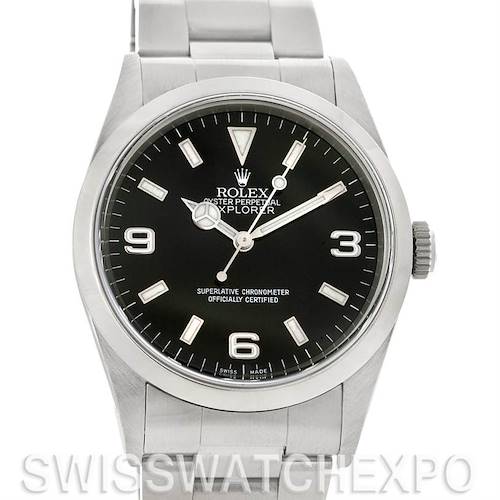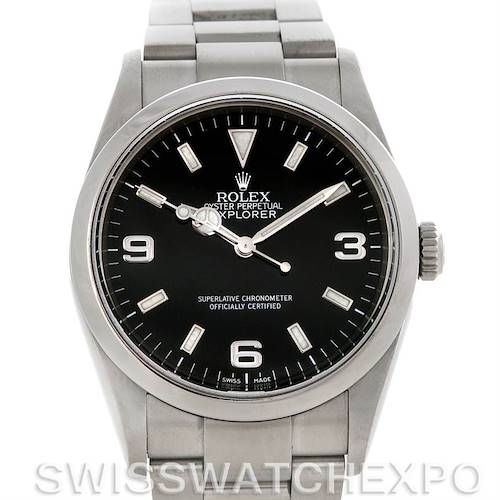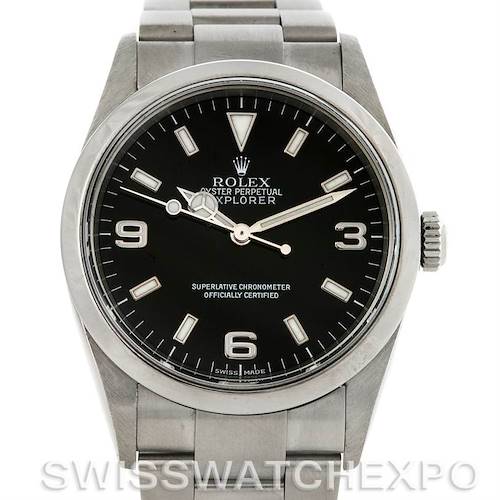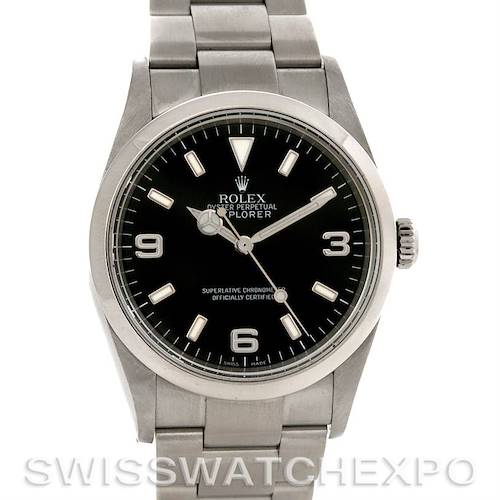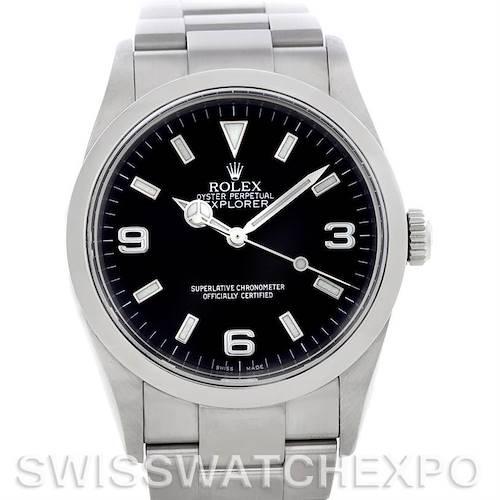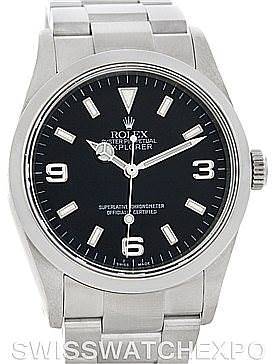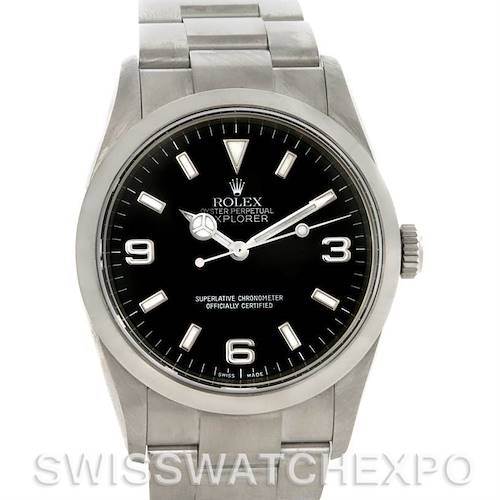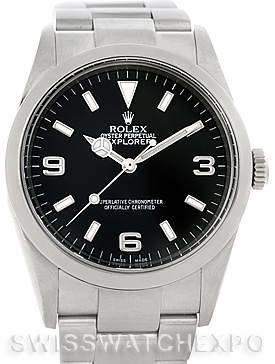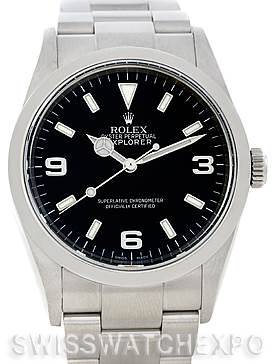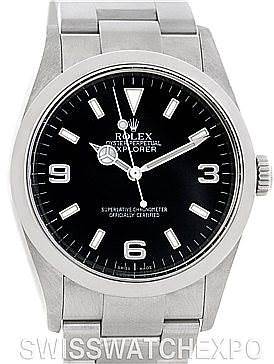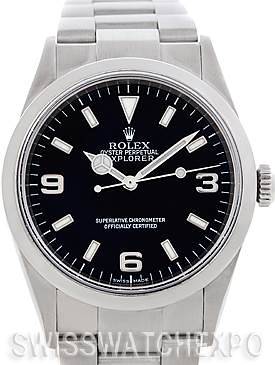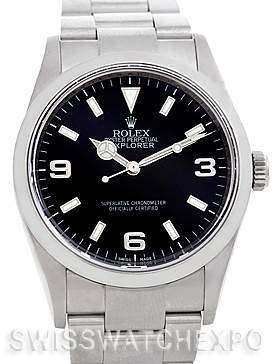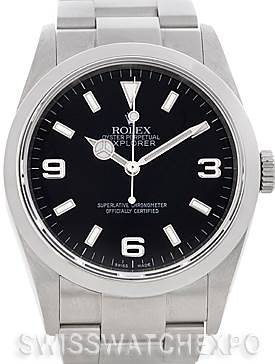- CALL US (404) 814-1814
- LIVE SUPPORT
- EMAIL US
-
WISHLIST (0)
-
CART(0)

Men's Explorer | Black | Rolex Watch Collection
913 MATCHES FOUND
Rolex Explorer Collection
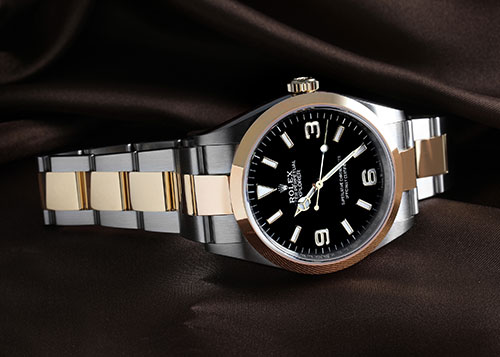
The Rolex Explorer collection symbolizes the brand’s deep involvement with exploration. Introduced in 1953, the Explorer is Rolex’s original sports watch, and its longest-running tool watch still in production today.
Its story famously began with the successful pioneering ascent of Sir Edmund Hillary and Tenzing Norgay to Mount Everest in 1953. Accompanied by modified Rolex Oyster Perpetual watches, the voyage also proved the reliability of Rolex watches in extreme conditions. That same year, Rolex introduced the first Explorer watch to celebrate the monumental climb. The robust and reliable timepiece quickly became an essential tool for the world’s most intrepid adventurers, who often faced the most extreme conditions.
The following decades saw the development of two families of watches under the Explorer collection – the Explorer I for scaling peaks, and the Explorer II for surveying the depths of caves.
Today, the Rolex Explorer collection is the choice of those who need robust and reliable timepieces that are stylish enough for any occasion. Explore our wide selection of Rolex Explorer watches at SwissWatchExpo.com.
A BRIEF HISTORY OF THE ROLEX EXPLORER COLLECTION
Rolex has a long history of creating watches for professionals. Tested in extreme conditions, Rolex’s tool watches do more than just tell time, but actually have vital life-saving functions. The Rolex Explorer was created with mountaineers in mind, and with the Himalayas as the laboratory.
The Rolex Explorer’s history can be traced back to the 1930s, when Rolex began supplying Himalayan explorers with watches. These timepieces were Oyster Perpetuals that were modified to keep perfect time while enduring environments at -50 degrees Fahrenheit and with 70% less oxygen than at sea level.
In 1953, Oyster Perpetual watches were provided to the British Mount Everest expedition, led by Colonel John Hunt. This voyage was the ninth attempt on the first ever ascent to the top of Mount Everest. On May 29, 1953, Edmund Hillary and Tenzing Norgay made history when they reached the summit.
To honor this achievement, Rolex introduced the first Oyster Perpetual Explorer watch that same year. The reference 6298 featured a durable stainless steel exterior, a legible dial with luminous markers and hands, and a shock-resistant self-winding mechanical movement.
Over the years, Rolex continued to improve on the Rolex Explorer I, adding aesthetic and technical improvements that have been key characteristics of the collection today. These include the chronometer-rated movement, 100m water resistance, black dials with the iconic 3-6-9 Arabic numerals, inverted triangle, and Mercedes-style hands.
Building upon the success of the Rolex Explorer I, the company introduced a second family of watches under the Explorer line. In 1971, Rolex launched the Explorer II – a bigger and bolder watch that was positioned as a tool watch for cave explorers, speleologists, and adventurers who spend extended periods in low-light conditions.
The Explorer II was equipped with a 24-hour bezel and a bright 24-hour hand to help the wearer tell daytime from nighttime hours.
Just like the original Explorer, the Explorer II has evolved through its decades of history, but its fundamental design has remained the same.
The Rolex Explorer collection continues to be part of the Rolex catalog today and serves as a paragon of robustness and reliability.
EVOLUTION OF THE ROLEX EXPLORER COLLECTION
The Rolex Explorer collection is composed of two families of watches that co-exist in the Rolex catalog: the Rolex Explorer I and the Rolex Explorer II. Made with adventurers in mind, both are practical self-winding timepieces with 100m water resistance, but they bear little resemblance to each other.
The Rolex Explorer I is a minimalist, time-only watch that holds the line between a sport and dress watch. The Rolex Explorer II, meanwhile, turns up the sportiness with a bigger, bolder case, larger markers and lume plots, a 24-hour bezel, and a bright 24-hour hand.
As is the case for long-running models from the brand's catalog, the Rolex Explorer I and Rolex Explorer II have undergone several variations throughout their history, while retaining their key characteristics. Below is a summary of different models of the Rolex Explorer through the years.
EVOLUTION OF THE ROLEX EXPLORER I
Introduced in 1953, the Rolex Explorer I is the brand’s oldest sport watch that is still in production. The original Explorer was built as a sturdy stainless steel timepiece featuring Rolex’s water-resistant Oyster case, self-winding Perpetual movement, and a clean, time-only dial that offered exceptional legibility with luminous markers and hands.
KEY FEATURES OF THE ROLEX EXPLORER I:
| Case diameter: | 36mm and 39mm |
| Material: | Stainless steel / 904L Steel / Oystersteel / Yellow Rolesor |
| Functions: | Time and running seconds |
| Bezel: | Smooth, fixed bezel |
| Dial: | Black with Arabic numerals at 3, 6 and 9 o’clock |
| Bracelet: | Oyster |
| Water resistance: | 50m (before 1959); 100m onwards |
PRE-EXPLORERS (1940s – 1953)
References: 6098 and 6298
In 1952, Rolex began supplying British explorers with large Oyster watches that were essentially prototypes of what would become the Explorer. In particular, the reference 6098 and 6298 were supplied to expedition members. They both featured 1950s Rolex Oyster dials with a closed minute track, applied arrow hour markers, and applied Rolex coronet. Powered by the A296 perpetual movement, which happened to be thick, these watches also featured a domed “bubble back”.
FIRST EXPLORER MODELS (1953 – 1955)
References: 6150 and 6350
These references are considered the first Rolex Explorer models. They were the first to feature the “Explorer” name on the dial as well as the 3-6-9 layout. Both ran on the self-winding A296 movement, which meant they had bubble case backs.
The key difference is that Rolex had the 6350 certified as a chronometer. Unlike the 6150 which had the word ‘Precision’ on its dial, the 6350 had the words ‘Officially Certified Chronometer’ stamped on its dial above 6 o’clock.
ROLEX EXPLORER ref 6610 (1955 – 1959)
In the mid-1950s, Rolex introduced their first in-house chronometer rated movement, the Caliber 1030. The new generation movement was a lot slimmer than its predecessors, therefore requiring a new case design. The Caliber 1030 was introduced with the Explorer ref 6610, which featured the new case shape, inverted triangle at 12 o’clock, and the Mercedes hands that were made standard for succeeding models.
ROLEX EXPLORER ref 1016 (1963 - 1989)
Again, the new Explorer reference was heralded by an improvement in the caliber. The ref 1016 was introduced with the new chronometer-certified Caliber 1560 – a staple movement in Rolex Oyster watches of the era. A decade later, the movement was slightly upgraded to the 1570 with a hacking-seconds feature. The ref 1016’s depth rating was also doubled to 100m.
Because of its long two-decade production history, there were many changes that were made on the ref 1016. One of the biggest changes that took place during its production was the shift in the material used for its luminescence. Until the mid-1960s, Rolex used radium for its markers and hands, until it became apparent that the material is toxic. Rolex began using tritium thereafter, which was signified by “Swiss T<25” and “T Swiss T” on the edge of the dials at 6 o’clock. The earlier glossy black dials were also replaced with matte black dials, and gilt indexes were replaced by white font.
ROLEX EXPLORER ref 14270 (1989 – 2001)
This reference marked the beginnings of the modern Rolex Explorer I. It had all the staples of the ref 1016, but also introduced the following upgrades: from painted markers to applied markers with white gold surrounds; replacing the acrylic crystal with scratch-proof sapphire crystal; and a newer movement in the form of the Caliber 3000. The case was also heftier, albeit still 36mm in diameter. Towards the end of the 1990s, Rolex replaced the Tritium dials with longer-lasting Super-Luminova lume.
ROLEX EXPLORER ref 114270 (2001 – 2010)
On the outside, this reference appears the same as its predecessor, but its movement was upgraded to the Caliber 3130, which included a full balance bridge and a Breguet overcoil hairspring.
ROLEX EXPLORER ref 214270 (2010 – 2020)
This reference ushered in one of the biggest changes in the Rolex Explorer I. The traditional 36mm case diameter was increased to 39mm. Changes were also present on the dial: the 3, 6, and 9 numbers which used to be luminescent were replaced by 18k white gold applied markers, and the “Explorer” text moved from below the Rolex logo to above 6 o’clock.
There are two dials under the reference 214270. The first version of the dial or the “Mark I” had hands that, to many Rolex fans, seemed too short for the 39mm case. Rolex introduced a fix to this in 2016 with the “Mark II”, which had better proportioned center hands and made the 3, 6 and 9 numerals luminescent again.
Both versions of the 214270 are powered by the Caliber 3132.
ROLEX EXPLORER ref 124270 / 124273 (2021 – present)
After a decade, the 39mm Rolex Explorer was discontinued in favor of the historical 36mm case size. Rolex introduced two new iterations of the Explorer I with a 36mm diameter – one in stainless steel (ref 124270) and the very first two-tone steel and yellow gold edition (ref 124273).
They are also equipped with the improved blue Chromalight luminous paint that glows for longer in the dark, and the new caliber 3230, which features a Parachrom hairspring, 70 hours of power reserve, and accuracy of +2 / -2 seconds per day.
EVOLUTION OF THE ROLEX EXPLORER II
If the Rolex Explorer was designed for polar and mountaineering explorers, its bigger sibling, the Rolex Explorer II, was created for cave explorers. Equipped with a stationary 24-hour bezel and a bright 24-hour hand, the Explorer II makes it easier to tell day from night.
KEY FEATURES OF THE ROLEX EXPLORER II:
| Case diameter: | 39mm (1971- 1985); 40mm (1985 – 2011); 42mm (2011-) |
| Material: | Stainless steel / 904L Steel / Oystersteel |
| Functions: | Time and date; GMT |
| Bezel: | Fixed 24-hour bezel |
| Dial: | Black or white with round, baton and triangular markers |
| Bracelet: | Oyster |
| Water resistance: | 100m |
ROLEX EXPLORER II ref 1655 (1971 – 1984)
The first Rolex Explorer II was introduced in 1971 with the ref 1655. It featured a 39mm stainless steel case, and a distinct steel 24-hour bezel. Unlike the Submariner and the GMT-Master, the Explorer II had its graduations engraved on the bezel (without the use of aluminum inserts) and the bezel was fixed (non-rotating).
Its other unique feature was the bright 24-hour orange hand. The large arrow was meant to hold more tritium lume and be easily readable when crawling through pitch dark caves. With the ref 1655, the 24-hour hand was not yet independent from the minute and hour hand, so it cannot be classified yet as a GMT. The 24-hour hand was more of an AM-PM indicator.
ROLEX EXPLORER ref 16550 (1985 – 1989)
The Rolex Explorer II as we know it today began to take shape with the ref 16550. It featured a 40mm stainless steel case and a 24-hour bezel with alternating numbers and inverted triangles. The hash-lined markers were replaced by applied round, baton, and triangular markers with white gold surrounds; and the stick hands were upgraded to the Mercedes-style hands that we see today on Rolex sport watches. The 24-hour hand was also replaced by a sleeker red hand with a smaller arrowhead.
The ref 16550 also introduced the series to a sapphire crystal, a white dial option, and the higher-beat Caliber 3085 movement. With the newer movement, the 24- hour hand became independently adjustable, turning the Explorer II from an AM/PM watch to a GMT watch with a jumping hour hand.
ROLEX EXPLORER ref 16570 (1989 - 2011)
The next reference is similar in design to the 16550, except that it was upgraded with the Caliber 3185, and later the Caliber 3186. Beginning 1998, Rolex shifted from the use of tritium to Super Luminova. The white dial or “Polar” versions of the ref 16570 also swapped the white gold hour marker surrounds to black, making them stand out even more.
ROLEX EXPLORER II ref 216570 (2011 - 2021)
This iteration of the Rolex Explorer II hit the market in time for the collection’s 40th anniversary. As a homage to the inaugural reference 1655, Rolex changed the red arrow hand to an oversized bright orange arrow hand. The case size was also increased to 42mm from 40mm.
Additionally, the ref 216570 features the Maxi Dial – a staple of modern Rolex sport watches that feature larger hour markers and broader hands, and Rolex’s patented luminescent material, Chromalight, which gives off a blue glow.
Lastly, Rolex also upgraded this reference with the Caliber 3187, which hasRolex’s own Paraflex shock absorbers.
ROLEX EXPLORER II ref 226570 (2021 - present)
For the Explorer II’s 50th anniversary in 2021, Rolex gave the watch subtle updates. Its proportions were updated with thinner lugs, while the slightly bigger bracelet gave it a more balanced look. It was also equipped with anti-reflective coating on the crystal and optimized Chromalight display to improve its legibility. It also comes with the new generation Caliber 3285, which features the Chronergy escapement and boasts of 70 hours of power reserve.
ROLEX EXPLORER REFERENCE NUMBERS
The table below shows the list of Rolex Explorer I and Explorer II references through the years, from older 4- and 5-digit references, to the modern 6-digit models.
ROLEX EXPLORER I REFERENCE NUMBERS
| REFERENCE NUMBER | SIZE | PRODUCTION YEARS | MATERIALS |
| 6150 | 36mm | 1953 | Stainless Steel |
| 6350 | 36mm | 1953 - 1955 | Stainless Steel |
| 6610 | 36mm | 1955 – 1959 | Stainless Steel |
| 1016 | 36mm | 1963 – 1989 | Stainless Steel |
| 14270 | 36mm | 1989 – 2001 | Stainless Steel |
| 114270 | 36mm | 2001 – 2010 | 904L Steel |
| 214270 | 39mm | 2010 - 2020 | Oystersteel |
| 124270 | 36mm | 2021 - present | Oystersteel |
| 124273 | 36mm | 2021 - present | Oystersteel and Yellow Gold |
ROLEX EXPLORER II REFERENCE NUMBERS
| REFERENCE NUMBER | SIZE | PRODUCTION YEARS | MATERIALS |
| 1655 | 39mm | 1971 - 1984 | Stainless Steel |
| 16550 / 16555 | 40mm | 1985 - 1989 | Stainless Steel |
| 16570 | 40mm | 1989 - 2011 | 904L Steel |
| 216570 | 42mm | 2011 - 2021 | Oystersteel |
| 226570 | 42mm | 2021 - present | Oystersteel |
COMMON QUESTIONS ABOUT THE ROLEX EXPLORER
The Rolex Explorer is the brand’s original sports watch, designed with adventurers in mind. Here are some of the most common questions asked about the Rolex Explorer.
WHAT IS A ROLEX EXPLORER?
The Rolex Explorer is a collection of robust, reliable, and stylish watches first created in 1953. Today, it is composed of two families of watches: the Explorer I, a simple time-only watch, and the Explorer II, a GMT sports watch. Both are loved for their robust build, exceptional legibility, and everyday versatility.
DOES THE ROLEX EXPLORER HOLD ITS VALUE?
As one of Rolex’s longest-running collections, the Explorer enjoys ubiquitous recognition. The versatile design also stands to continue gaining value, as even older designs remain wearable even decades after. With the introduction of new models in 2021, the Rolex Explorer also enjoyed a resurgence in interest. All these factors help secure the value of the Rolex Explorer.
IS THE ROLEX EXPLORER A GOOD WATCH?
The Explorer is Rolex’s original sports watch. Introduced in 1953, it traces its beginnings to the prototype Oyster watch used in the pioneering ascent to Mount Everest. A black dial with large Arabic numerals at 3, 6, and 9 o'clock, and a prominent inverted triangle at 12 o'clock have been defining features of the Explorer since its debut.
It has been made in stainless steel since its debut, but now comes in a two-tone steel and gold version introduced in 2020. Its no frills design and time-only dial makes the Explorer Rolex’s most affordable and wearable sports watch models.
The Explorer exudes a sporty character but still looks elegant enough to be worn with a suit and tie. This makes it a great choice for people who want an all-rounder watch.
HOW WILL I KNOW IF MY ROLEX EXPLORER IS GENUINE?
Rolex Explorer watches are built for extreme conditions, and are crafted in keeping with Rolex’s uncompromising quality standards.
If the watch is lacking in heft, or if you see any sign of imperfection on the watch - such as misaligned and misspelled text or unfinished surfaces - it is likely a fake.
Rolex Explorer models are also well-documented. It is always advisable to do research beforehand so you can make yourself familiar with the model’s supposed features.
We also advise clients to only purchase a watch from a reputable and trusted retailer, who can provide a guarantee of authenticity on the watch.
IS THE ROLEX EXPLORER WATERPROOF?
The Rolex Explorer I and Rolex Explorer II are guaranteed water resistant to a depth of 100 meters or 330 feet. They come with Rolex’s signature screw-down crowns and case backs, which protect the movement from moisture and dust that can be encountered with daily or sporting use.


